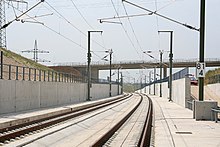
A bogie is a chassis or framework that carries a wheelset, attached to a vehicle—a modular subassembly of wheels and axles. Bogies take various forms in various modes of transport. A bogie may remain normally attached or be quickly detachable ; it may contain a suspension within it, or be solid and in turn be suspended ; it may be mounted on a swivel, as traditionally on a railway carriage or locomotive, additionally jointed and sprung, or held in place by other means.

A railroad switch (AE), turnout, or [set of] points (CE) is a mechanical installation enabling railway trains to be guided from one track to another, such as at a railway junction or where a spur or siding branches off.
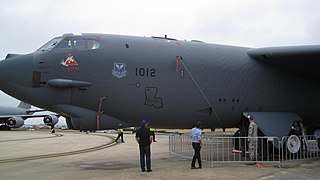
In structural engineering, buckling is the sudden change in shape (deformation) of a structural component under load, such as the bowing of a column under compression or the wrinkling of a plate under shear. If a structure is subjected to a gradually increasing load, when the load reaches a critical level, a member may suddenly change shape and the structure and component is said to have buckled. Euler's critical load and Johnson's parabolic formula are used to determine the buckling stress of a column.
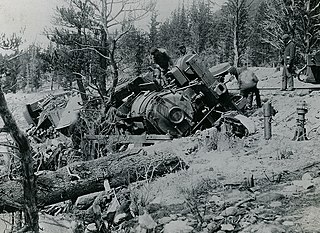
In rail transport, a derailment occurs when a rail vehicle such as a train comes off its rails. Although many derailments are minor, all result in temporary disruption of the proper operation of the railway system and they are a potentially serious hazard.

An adhesion railway relies on adhesion traction to move the train. Adhesion traction is the friction between the drive wheels and the steel rail. The term "adhesion railway" is used only when it is necessary to distinguish adhesion railways from railways moved by other means, such as by a stationary engine pulling on a cable attached to the cars or by railways that are moved by a pinion meshing with a rack.
A banked turn is a turn or change of direction in which the vehicle banks or inclines, usually towards the inside of the turn. For a road or railroad this is usually due to the roadbed having a transverse down-slope towards the inside of the curve. The bank angle is the angle at which the vehicle is inclined about its longitudinal axis with respect to the horizontal.

A transition curve is a spiral-shaped length of highway or railroad track that is used between sections having different profiles and radii, such as between straightaways (tangents) and curves, or between two different curves.
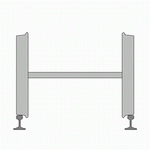
Hunting oscillation is a self-oscillation, usually unwanted, about an equilibrium. The expression came into use in the 19th century and describes how a system "hunts" for equilibrium. The expression is used to describe phenomena in such diverse fields as electronics, aviation, biology, and railway engineering.

In railway engineering, cant deficiency is defined in the context of travel of a rail vehicle at constant speed on a constant-radius curve. Cant itself refers to the superelevation of the curve, that is, the difference between the elevations of the outside and inside rails. Cant deficiency is present when a rail vehicle's speed on the curve is greater than the speed at which the components of wheel to rail force are normal to the plane of the track. In that case, the resultant force exerts on the outside rail more than the inside rail, in which it creates lateral acceleration toward the outside of the curve. In order to reduce cant deficiency, the speed can be reduced or the superelevation can be increased. The amount of cant deficiency is expressed in terms of required superelevation to be added in order to bring the resultant force into balance between the two rails.
Cross slope, cross fall or camber is a geometric feature of pavement surfaces: the transverse slope with respect to the horizon. It is a very important safety factor. Cross slope is provided to provide a drainage gradient so that water will run off the surface to a drainage system such as a street gutter or ditch. Inadequate cross slope will contribute to aquaplaning. On straight sections of normal two-lane roads, the pavement cross section is usually highest in the center and drains to both sides. In horizontal curves, the cross slope is banked into superelevation to reduce steering effort and lateral force required to go around the curve. All water drains to the inside of the curve. If the cross slope magnitude oscillates within 1–25 metres (3–82 ft), the body and payload of high (heavy) vehicles will experience high roll vibration.

The Ewing System is a balancing monorail system developed in the late 19th century by British inventor W. J. Ewing. It is not to be confused with the much later system patented by Robert W. Ewing.

In railway engineering, curve resistance is a part of train resistance, namely the additional rolling resistance a train must overcome when travelling on a curved section of track. Curve resistance is typically measured in per mille, with the correct physical unit being Newton per kilo-Newton (N/kN). Older texts still use the wrong unit of kilogram-force per tonne (kgf/t).
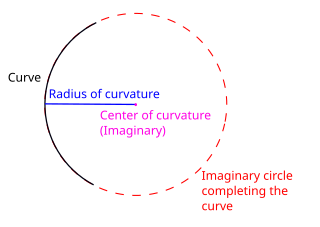
In differential geometry, the radius of curvature (Rc), R, is the reciprocal of the curvature. For a curve, it equals the radius of the circular arc which best approximates the curve at that point. For surfaces, the radius of curvature is the radius of a circle that best fits a normal section or combinations thereof.
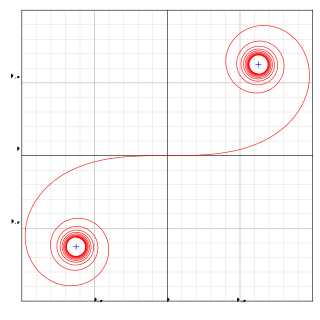
An Euler spiral is a curve whose curvature changes linearly with its curve length. Euler spirals are also commonly referred to as spiros, clothoids, or Cornu spirals.
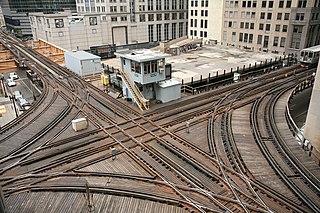
The minimum railway curve radius is the shortest allowable design radius for the centerline of railway tracks under a particular set of conditions. It has an important bearing on construction costs and operating costs and, in combination with superelevation in the case of train tracks, determines the maximum safe speed of a curve. The minimum radius of a curve is one parameter in the design of railway vehicles as well as trams; monorails and automated guideways are also subject to a minimum radius.

Rail speed limits in the United States are regulated by the Federal Railroad Administration. Railroads also implement their own limits and enforce speed limits. Speed restrictions are based on a number of factors including curvature, signaling, track condition, and the presence of grade crossings. Like road speed limits in the United States, speed limits for tracks and trains are measured in miles per hour (mph).

The geometric design of roads is the branch of highway engineering concerned with the positioning of the physical elements of the roadway according to standards and constraints. The basic objectives in geometric design are to optimize efficiency and safety while minimizing cost and environmental damage. Geometric design also affects an emerging fifth objective called "livability," which is defined as designing roads to foster broader community goals, including providing access to employment, schools, businesses and residences, accommodate a range of travel modes such as walking, bicycling, transit, and automobiles, and minimizing fuel use, emissions and environmental damage.
A railway or railroad is a track where the vehicle travels over two parallel steel bars, called rails. The rails support and guide the wheels of the vehicles, which are traditionally either trains or trams. Modern light rail is a relatively new innovation which combines aspects of those two modes of transport. However fundamental differences in the track and wheel design are important, especially where trams or light railways and trains have to share a section of track, as sometimes happens in congested areas.

Track geometry is concerned with the properties and relations of points, lines, curves, and surfaces in the three-dimensional positioning of railroad track. The term is also applied to measurements used in design, construction and maintenance of track. Track geometry involves standards, speed limits and other regulations in the areas of track gauge, alignment, elevation, curvature and track surface. Standards are usually separately expressed for horizontal and vertical layouts although track geometry is three-dimensional.

Rail squeal is a screeching train-track friction sound, commonly occurring on sharp curves.

